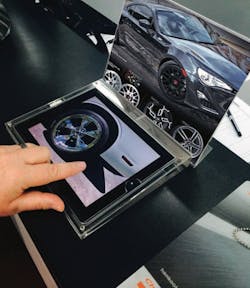I conducted a survey this week, a 1-to-10 marketing survey, to better understand the ultra-high performance tire and wheel buyer. I spoke with management and frontline sales staff at one of Southern California’s leading UHP retailers.
The results were interesting, perhaps predictable. But one thing is for sure: You won’t accidentally sell more UHP tires, wheels and accessories.
In an attempt to better understand and profile the typical UHP tire and wheel buyers, I asked a number of questions about the following:
* tire brands,
* looks and style,
* consumer past experience,
* brand reputation,
* the blog community,
* UTQG ratings,
* sales presentations,
* manufacturer rebates,
* the importance of the Internet, and
* pricing.
The management and sales staff all responded with various questions, but made the same statement: “These are all very important, depending on the customer.” There are a wide variety of items that have varying value from customer to customer.
The higher the number, the more important the topic was to the UHP buyer. Almost all the survey answers were rated an 8, 9 or 10. The fact that most every category rated 8 or higher means there is a tremendous amount of relevancy across all points with UHP buyers.
As we all know, today’s tire consumer has more information available to him or her, and the UHP consumer is even more knowledgeable. The primary difference between a commodity-performance buyer or an original-equipment-replacement-performance tire buyer and the UHP buyer is knowledge and enthusiasm. The UHP buyer in most cases has done more research and has more questions, questions that must be answered properly and professionally.
A recent extensive automotive aftermarket survey stated that 85% of all automotive aftermarket shopping starts online. Wow! As I’ve spoken with frontline sales staff and owners, it feels more like 100%.
How, then, do you service the UHP customer when they arrive at your location and are hours ahead on their research? They actually know more than you about their particular fitment. The answer is you must catch up fast. It seems that everybody is more impatient these days. As a result, I figure you have about two to five minutes to catch up and get on the same page. If you don’t, you’re toast.
May I offer a simple four-step process?
1. Listen up.
2. Catch up.
3. Shut up.
4. Speak up.
And if you get any of these out of order, you’ll screw up!
[PAGEBREAK]
You must research the customer’s research; you must become their tire and wheel concierge. While researching their research, listen up and ask fact-finding questions. You will learn what’s most important to them, and they will, in essence, catch you up.
If you talk too much, then you will slow the process. So be quiet until you feel both parties have established enough confidence. Then begin asking more pointed questions and making recommendations.
As you are carefully listening, the customers will reveal some likes and dislikes. Affirm their likes, and avoid their dislikes.
At this point, make opening comments and recommendations that support what you have heard from the customer; in other words, speak up. You will need resources, real counter intelligence tools that assist you in presenting products, presenting relevant data that will support your ultimate recommendations and allow you to close the sale.
You can’t make it up as you go. UHP sales are for professionals and those who are prepared.
In the survey I conducted, there were two questions that received unanimous 10’s from each respondent: The importance of the Internet and prices. You can’t hide from the Internet, and pricing is going to be a part of the process.
You will need fitment guides. As a former tire salesman myself, I almost always referred to a fitment guide, even if I was 100% sure of an accurate fitment. This demonstrated to the customers my professionalism and concern for their safety.
To get the sale, you will need to establish this type of confidence.
Secondly, you will need digital solutions, digital tools that deliver accurate answers. Today, more than ever, answers are found digitally. Answers are not in a three-ring binder or a stack of the latest wheel catalogs.
If you’re not digitally prepared with the UHP customer, you’re going to end up selling 17-inch tires for Honda Civics and 15-inch tires for Ford Rangers.
On the wheel side, besides well-merchandised wheels and reliable wheel vendors, you’ll need “configurators” that show wheels on vehicles. The customer has been online, used these configurators and has selected certain wheels for his/her vehicle.
You must shop alongside your customers and be their wheel and tire advisor. If the Internet provides a better visual presentation or shopping experience or better price than you do, then you’re not going to enjoy the additional UHP sales and profits.
Your “A” game is not enough with today’s UHP tire and wheel buyers. Your “AA” game must include professional presentations of accurate fitments and popular styles, both digitally and manually, that help you close the UHP sale.
And here’s one more piece of advice: Check with your vendors and search the industry for the latest power tools to help you win in the UHP arena. ●
Wayne Williams is president of ExSell Marketing Inc., a “counter intelligence” firm based in La Habra, Calif. He can be reached via email at [email protected].
Eighty-five percent of automotive aftermarket purchases begin with consumers doing research online. That means they might have the jump on you concerning the specific products they want, and you have to catch up — fast, or lose the sale.

